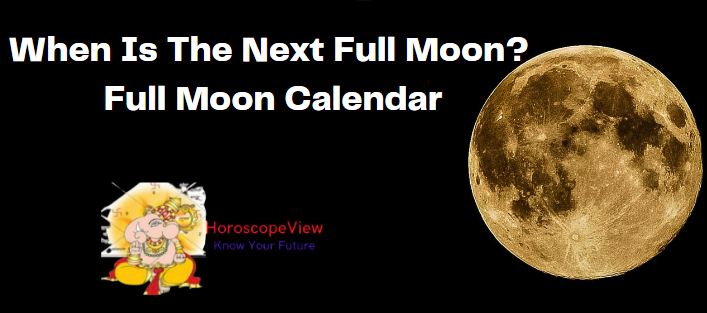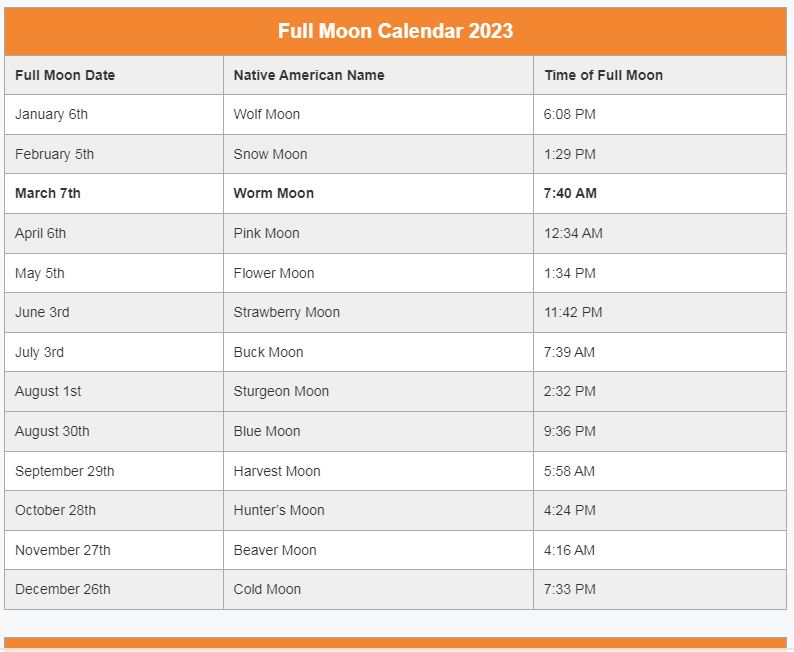When Is The Next Full Moon? – In this post, you will read more about the next full Moon and Moon Phases. The next full moon occurs on Tuesday, 7th March 2023 at 7:40 AM EST – Eastern Time, and is well known as the Worm Moon. Technically speaking, the Moon is only full for an instant, however, to us looking at the Moon in the sky, it can look “full” for up to 3 days? A full Moon happens anytime of the day or the night time. In this post, you will see the exact times for all full Moons in 2023.
Learn more about this month’s full Moon by in our video below:
When Is The Next Full Moon?
7th March 2023 at 07:40 AM Eastern Time (Worm Moon).
Check the dates for every full Moon in 2023.
What is a full Moon?
A full Moon occurs when the Moon appears as a full circle in the sky to us. We see the Moon as a full orb as the whole of the side of the Moon facing the Earth is lit up by the Sun’s rays.
The Moon produces no visible light of its own title, however, we can only see the parts of the Moon that are lit up by other objects. A small amount of light will come from distant stars and the reflection of light from the Earth which is known as ‘Earthshine‘. However the primary source of light for the Moon is the Sun.
Get Your Soulmate Drawing (Exact Image)
Many People Are Shocked To See What Their Soulmate Actually Looks Like.
The Moon appears in the sky as different shapes depending on its ‘phase’, from new Moon to full Moon via -waxing that is growing and ‘waning’ which is shrinking moons.
These moon phases are fully determined by the relative positions and location of the Sun, Earth and Moon.
If the Moon is between the Sun and the Earth in its orbit, then the back-side of the Moon is -lit up and the side-facing the Earth is in darkness. This is called a new Moon in astronomy.
If the Moon is placed or located on the opposite-side of the Earth to the Sun, then the near-side of the Moon will be fully -lit up: a full Moon. Find below full Moon 2023 Calendar.
Full Moon Names And Their Meanings
Full Moon names date-back to the Native Americans of -North America. Tribes kept track of the all seasons by giving distinctive names to each recurring full-Moon. The Full Moon names were applied to the entire month in which each occurred.
There were some variations in the full Moon names however, in general, the same ones were consistent among regional tribes. European settlers completely and dedicate followed that custom and created some of their own names for the Moon.
Fine below a Complete Farmers Almanac’s list of the Full Moon names and its meanings.
January — Full Wolf Moon
Amid the cold and snows of mid-winter, the wolf packs howled hungrily outside Indian villages. The name for January’s full Moon.
Sometimes it was referred to as the Old-Moon, or the Moon After Yule. Some called it the -Full Snow Moon, however, most tribes applied that name to the next Moon.
February — Full Snow Moon
Since the heaviest snow usually falls during this February, native tribes of the North and East part most often called February’s full Moon the Full Snow Moon. Some tribes referred to this Moon as the Full Hunger Moon as harsh weather conditions in their areas made hunting very difficult.
March — Full Worm Moon
As the temperature begins to warm slowly and the ground begins to thaw, earth-worm casts appear, heralding the return of the robins. The more northern tribes knew this Moon as the Full Crow Moon, when the cawing of crows signaled the -end of winter; or the Full Crust Moon, as the snow cover crusted from thawing by day and freezing at night time.
The Full Sap-Moon, marking the time of tapping maple-trees, is another variation. To the settlers, it was known as the Lenten Moon, and was considered to be the last full Moon of winter season.
April — Full Pink Moon
This name Full Pink Moon came from the herb moss pink, or wild ground phlox, which is one of the earliest widespread flowers of the spring season. Other names for April month’s celestial body include the Full Sprouting Grass Moon, the Egg Moon, and among coastal tribes the Full Fish Moon, as this was the time that the shad swam upstream to spawn.
May — Full Flower Moon
In most areas, flowers are abundant around May. Thus, the name of this Moon is. Other names include the Full Corn Planting Moon, or the Milk Moon.
June — Full Strawberry Moon
This name Full Strawberry was universal to every Algonquin tribe. However, in Europe continental those natives called it the Rose Moon. As the relatively short season for harvesting strawberries comes each and every year during the June Month without any doubt. Therefore, the full Moon that occurs during June month is christened for the strawberry.
July — Full Buck Moon
July month is normal when the new antlers of buck-deer push out of their foreheads in coatings. It was called the Full-Thunder Moon, for the reason that thunderstorms are most frequent during July and another name for it was the Full Hay Moon.
August — Full Sturgeon Moon
The fishing tribes are given credit for the naming of Full Sturgeon Moon, as sturgeon, a large fish of the Great Lakes and other major bodies of water, were most readily caught during August. A few tribes knew it as the -Full Red Moon as the Moon rises, it appears reddish colour through any sultry haze. It was also called -Green Corn Moon or Grain-Moon.
September — Full Harvest Moon (or Full Corn Moon)
Full Harvest full Moon name is attributed to Native Americans as it marked when corn was supposed to be harvested. Most often, the September month full Moon is actually the Harvest Moon, that is the full Moon that occurs closest to the fall equinox.
In 2 years out of three, the Harvest Moon comes in September month, however, in some years it occurs in October. At the peak of harvest, the farmers work late at night by the light of this Moon.
Usually the full Moon rises an average of around 50 minutes later each night, however, for the few nights around the Harvest Moon, the Moon seems to rise at nearly the same time each night: just 25 – 30 minutes later across the U.S., and only 10 – 20 minutes later for much of Canada and Europe continental.
October Full Hunter’s Moon or Full Harvest Moon)
October Month full Moon is referred to as the Full Hunter’s Moon, Sanguine Moon or Blood Moon. Native Americans named this bright Moon for obvious several primary and important reasons. The leaves are falling from trees, the deer are fattened, and it’s the perfect time to begin storing up meat for the long winter ahead.
Because the fields were traditionally reaped in late September or early October month, hunters could easily see fox and other animals that come out to glean from the fallen grains. Probably the threat of winter looming close, the Hunter’s Moon is accorded with special honor, serving as an important feast day in both Western Europe continental and among many Native American tribes.
November — Full Beaver Moon
This was the perfect time to set beaver traps before the swamps froze, to make sure of a supply of warm winter furs. Another interpretation says that the name Full Beaver Moon comes from the fact that the beavers are now actively preparing for the winter season. It is sometimes also referred to as the Frosty Moon.
December Full Cold Moon Or Full Long Night’s Moon)
During December month the winter (season) cold fastens its grip, and the nights are at their longest and really very darkest. It is sometimes called the Moon before Yule.
The term Long Night’s Moon is a doubly appropriate moon name as the mid-winter night is indeed long, and as the Moon is above the horizon for a long time. The mid-winter full Moon has a high trajectory across the sky as it is opposite a low Sun.
Blue Moon
For more than half a century, two full Moons appeared in a single month which happens on average every 2 1/2 – 3 years. The 2nd full Moon has been christened a Blue Moon.
However, there’s another definition of the Blue Moon that has to do with the number of full Moons throughout a single season now. When a particular season ends up containing four full-Moons, then the third is called a Blue Moon.
Thanks for reading and sharing this guide.




Leave a Reply